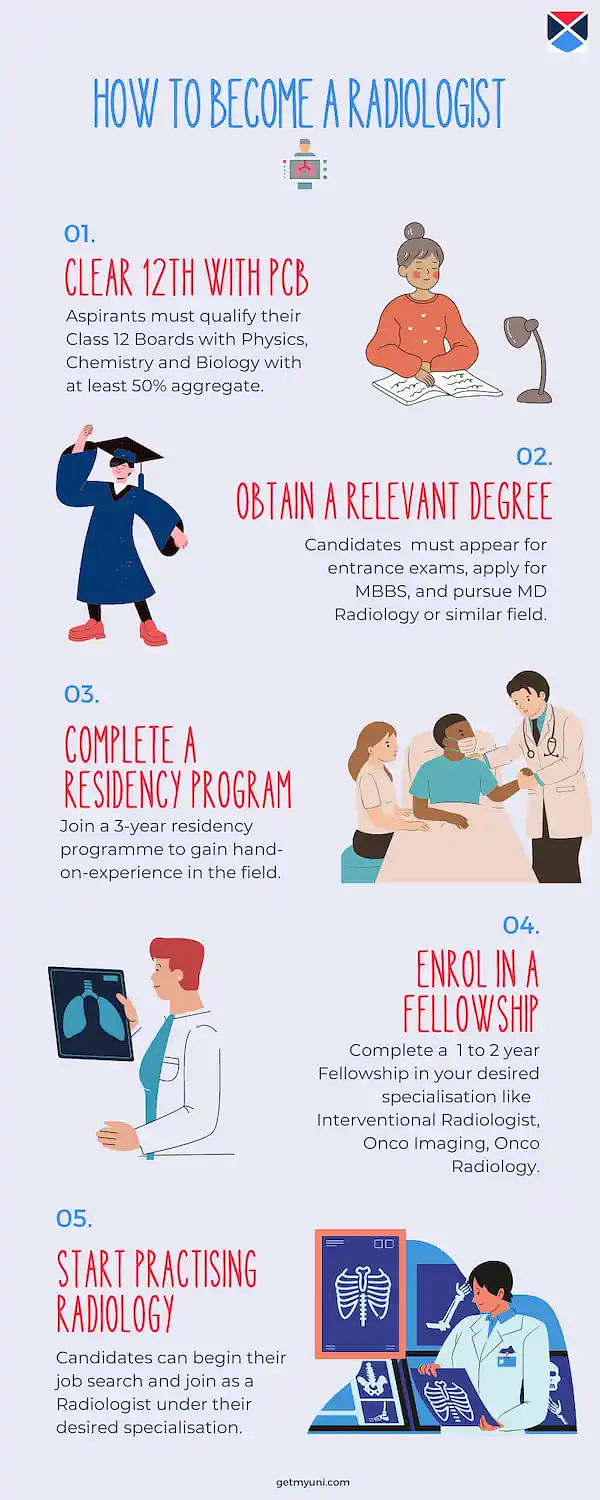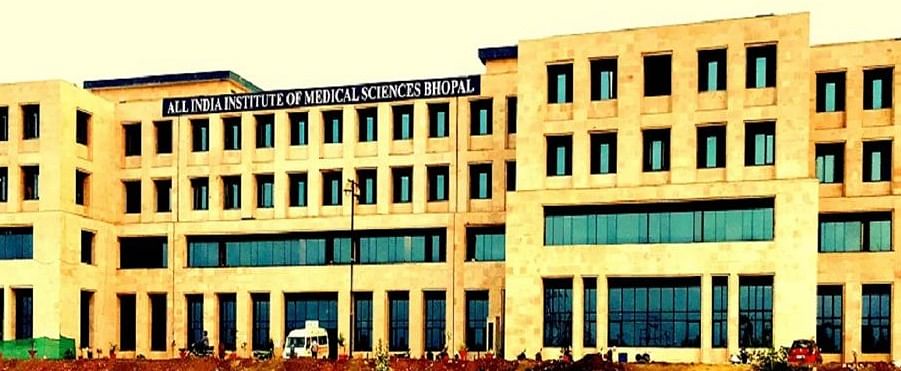Is being a Radiologist your dream career option? Check out the complete step by step process on how to become a Radiologist, Eligibility, Exams, Skills Required and Salary in 2023.
Radiologists diagnose injuries, illnesses, and other conditions using medical imaging, tests, CT scans, MRIS PET scans, USG etc. They perform and study the results produced by the machines or technology and create reports on the condition and treatment route. With the rise of acute diseases, the demand for radiologists has grown and is expected to increase by 5% in the coming years.
To become a radiologist, candidates must complete 5-year graduation and 2-year post graduation in radiology and gain experience through residency and fellowship to land a job as a Radiologist. The average radiologist salary in India is INR 23,58,977 PA. Candidates need to be anatomically and technically knowledgeable to succeed in the field.
Table of Contents:
- How to Become a Radiologist?
- Who is a Radiologist?
- How long does it take to become a Radiologist?
- What Does a Radiologist Do?
- Skills Required to Become a Radiologist
- Types of Radiologists
- Salary of a Radiologist
- Top Recruiters of Radiologists
- Benefits of Becoming a Radiologist
- Drawbacks of Becoming a Radiologist
- Radiologist Career Scope in India
How to Become a Radiologist?
Candidates wanting to know the steps to become a Radiologist can refer to the below steps. It is a unique branch for doctors to take up. However, candidates must follow a similar pattern as a Doctor to become a Radiologist.
- Step 1: Clear 12th with PCB
- Step 2: Obtain a Relevant Degree
- Step 3: Complete a Residency Program
- Step 4: Enrol in a Fellowship
- Step 5: Start Practising Radiology

Step 1: Clear 12th with PCB
Aspirants of Radiology must take note of the following points for Radiologist educational criteria requirements.
- Candidates must take Science stream with Physics, Chemistry, Biology and English for Classes 11 and 12.
- Aspirants must clear their class 12 Board exams with at least 50% marks to become a Radiologist.
- Candidates must simultaneously prepare for entrance exams.
Step 2: Obtain a Relevant Degree
Once candidates complete their school-level education, they must appear for entrance exams, apply for UG courses, and pursue PG courses.
Entrance Examinations
For admission to UG courses, candidates need to appear for NEET UG. Later, candidates need to take the NEET PG and NEET SS exams for PG-level education. Candidates can apply for an MBBS course for Radiologists with NEET UG scores. Complete details of the entrance exams for Radiologists are mentioned in the table.
|
Level |
Entrance Exam |
RegistrationFee Details |
Eligibility |
|
Undergraduate Courses |
NEET UG |
INR 1600 |
|
|
Post Graduate Courses |
NEET PG |
INR 4250 |
|
|
Doctorate |
NEET SS |
INR 5000 |
|
UG Degree
Candidates who qualify in NEET UG and meet the cutoff criteria for admission can apply for MBBS. An MBBS course is a 4-year and 6-month academic degree course, followed by a mandatory internship of 1 year at a teaching hospital.
If candidates want to become a Radiologist without MBBS, they may take up 3-year undergraduate courses. All radiology courses after the 12th that students can pursue are mentioned below.
|
Programme |
NEET UG Requirement |
Duration |
|---|---|---|
| Bachelor of Medicine and Bachelor of Surgery (MBBS) | Yes | 5 Years |
| Bachelors of Science (B.Sc) in Radiography | No | 3 Years |
| Bachelors of Science (B.Sc) in Medical Radiography & Imaging Technology | No | 6 Years |
| DNB - Radio Diagnosis | Yes | 3 Years |
| Diploma in Radiology Therapy (DMRT) | No | 6 Months to 2 Years |
| Diploma in Medical Radio Diagnosis (DMRD) | No | 6 Months to 2 Years |
PG Degree
Candidates must further specialise in courses like MD Radiology or MS Radiology. However, candidates must complete their MBBS with an internship and clear NEET PG to pursue the mentioned courses. These two-year specialisation courses will teach candidates about radio imaging, radio diagnosis, medical technology radiology, radiography, etc.
On the other hand, aspirants can pursue other master's courses in Radiology without NEET PG, the course details are mentioned below.
|
Programme |
NEET PG Requirement |
Duration |
|---|---|---|
|
MD Radiology |
Yes |
2 Years |
|
MS Radiology |
Yes |
2 Years |
|
MSc in Medical Radio Imaging |
No |
2 Years |
|
Master of Science (M.Sc) in Medical Imaging Technology |
No |
2 Years |
|
Master of Science (M.Sc) in Radiology |
No |
2 Years |
|
DNB (post-diploma) Radio Diagnosis |
Yes |
2 Years |
|
Post Graduate Diploma in Medical Radio Diagnosis |
No |
2 Years |
Doctorate
If candidates want to pursue higher studies and research, they may take up a PhD in Radiology and Radiological Sciences. It is a 3-year course which entails concepts such as ultrasound, imaging techniques, radiation etc. Eligibility required for admission to PhD in Radiology is 55% marks in MD or MS Radiology.
Top Colleges for Radiologists
Candidates wanting to become a Radiologist can check the top colleges in India for Radiology and related courses.
|
Name of College |
Average Annual Fee |
|
All India Institute for Medical Science, New Delhi |
INR 1150 |
|
Christian Medical College, Vellore |
INR 23,280 |
|
Lady Hardinge Medical College, New Delhi |
INR 13,000 |
|
Madras Medical College, Chennai |
INR 49,000 |
|
King George Medical College, Lucknow |
INR 30,000 |
|
Bangalore Medical College and Research Institute, Banglore |
INR 54,409 |
|
Kempegowda Institute of Medical Science, Bangalore |
INR 2,05,000 |
|
Maharaja Agrasen Medical College, Agroha |
INR 1,80,000 |
|
Assam Medical College, Dibrugarh |
INR 25,000 |
|
St. Johns Medical College, Banglore |
INR 11,00,000 |
Step 3: Complete a Residency Program
To become a Radiologist in India, candidates must join a 3-year residency programme. Here candidates will work with established Radiologists and learn implementation in a practical setting. Details of the residency process are mentioned below.
- The first year of residency is for practising general medicine and surgery.
- Candidates will focus on radiological sciences and technology in the next two years.
- Aspirants will learn image-guided methods to detect ailments.
- They will study images and interpretations.
- Also, candidates will interact with patients to study conditions.
A residency program is essential for candidates wanting hands-on experience before joining a hospital as a full-time Radiologist.
Step 4: Enrol in a Fellowship
Candidates who want to pursue further specialisation, such as Interventional Radiologist, Onco Imaging, Onco Radiology, Pediatric Radiology, PET Imaging etc., can join fellowships, an intensive neuro and peripheral vascular interventional radiology training program. Fellowships usually last for 1 to 2 years. The minimum requirement to enrol for fellowships in India is MD or DNB in Radiology.
Step 5: Start Practising Radiology
In India, Radiologists do not require a licence to practise out of an existing hospital or medical institute. Hence, candidates begin looking for radiologist jobs and join under their desired specialisation.
Who is a Radiologist?
A radiologist is a licensed medical expert who uses diagnostic radioscopy and technology to diagnose conditions in a patient. Radiologists perform tests such as CT scans, MRI, X-rays, Ultrasound, PET and more. They use the results and create detailed reports of the interpretation and suggest further steps to be taken, like the route of prognosis etc.
Candidates aspiring to become Radiologists must note that they will deal with pictorial observations and will not treat patients through general medicine or therapy like other doctors.
How Long Does it Take to Become a Radiologist?
Due to the vast educational criteria, candidates must dedicate up to 10 to 13 years to become a Radiologist in India. Moreover, the extensive training process adds to the duration of becoming a radiologist.
Although, all the hard work and dedication is a valid investment. Candidates will join a noble profession with an excellent reputation and salary package.
What Does a Radiologist Do?
A Radiologist is a specialised medical expert who interprets medical imaging as reports for diagnosis and prognosis purposes. Other than their traditional role, Radiologists perform a host of duties, such as,
- Deciding the type of imaging based on the ailment the patient is suffering from.
- Check the previous medical of the patient.
- Radiologists conduct imaging procedures with the assistance of an imaging specialist or solo.
- Study the medical images and create reports based on the interpretations.
- Assist fellow physicians in offering preferred treatment routes and if further imaging is required.
- They lead all imaging techniques.
Skills Required to Become a Radiologist
The skills required to become a successful Radiologist are communication, technical aptitude, problem-solving, attention to detail, anatomical knowledge and analytical skills. Let us run through these major skills in detail below.
Technical Aptitude
Radiologists must be trained and equipped to control radiological machines and equipment such as CT, X-ray, and MRI scanners. Technical knowledge is crucial as the primary responsibility of a Radiologist is to use their equipment to derive a patient's condition.
Anatomical Knowledge
Since radiologists work in an Institution's main facet of medical wings, they must be a pro in human anatomical knowledge. They can interpret the imaging better and provide accurate reports with their knowledge.
Problem-solving
Since radiologists deal with both patients and technical machines and instruments, they face inconveniences daily. They must use their analytical and problem-solving skills to solve these issues logically.
Communication Skills
As a Radiologist, candidates must communicate with patients, technicians and doctors. With the image they provide, they must be able to communicate to the parties mentioned above what the cause of the condition is and how the physician can treat the ailment.
Stress Endurance
Like all medical professions, the work environment of a Radiologist is highly stressful as it requires them to produce expert reports and conduct technical imaging. They work with a huge number of patients every day, which is why the workload must be heavy. Thus they must be able to handle stress.
Types of Radiologists
With different specialisations in Radiology, candidates can select a career option and work towards it to become a particular type of radiologist. The various types of radiologists are mentioned below.
1. Diagnostic Radiologist
A diagnostic radiologist uses images such as X-rays to determine conditions in a patient. They help physicians diagnose diseases, check improvements in patient condition through medical imaging, and flag different conditions such as heart disease, lung infection etc. Diagnostic Radiologists help in imaging procedures for breast cancer, colon cancer or cardiac conditions.
2. Interventional Radiologist
Interventional Radiologists use CT scanners, MRI and Ultrasound procedures to produce images to interpret results. This type of imagining is required when a patient requires the insertion of catheters, wires and other biomedical tools in the body. Interventional Radiologists assist in treating cancers, arterial blockage, liver issues and back pain.
3. Onco Radiologist
Onco Radiologists perform radiation techniques and therapy to treat ailments such as cancer. They use radiation to destroy cancer cells or keep them in control. They are skilled in prescribing doses required for different cancers keeping in mind the patient's health. They also suggest the best therapy to treat a disease.
4. Neuroradiologist
A neuroradiologist helps examine conditions related to the nervous system, spine, head and neck. They use neuroimaging techniques to determine the growth of tumours, diagnosis of stroke and other neuro conditions. Moreover, they execute angiographic procedures of the spine and brain to derive correct studies.
5. Paediatric Radiologist
A Paediatric radiologist implements medical imaging to study infections, ailments and injuries in infants, children and adolescents. The most commonly used methods are X-rays, computed tomography, and magnetic resonance imaging. They are highly trained paediatric imaging specialists who also maintain the safety of the patients during their diagnosis process.
Salary of a Radiologist
The biggest benefit of becoming a Radiologist is the high salary they earn. In India, the average Radiologist salary is INR 23,58,977 PA, according to Payscale.com. Candidates can check the designation-wise radiologist salary in India below.
|
Designation |
Average Annual Salary |
|
Interventional Radiologist |
INR 2,00,000 to 30,00,000 PA |
|
Diagnostic Radiologist |
INR 3,00,000 to 11,00,000 PA |
|
Onco Radiologist |
INR 1,00,000 to 29,70,000 PA |
|
Neuroradiologist |
INR 12,00,000 to 40,00,000 PA |
|
Paediatric Radiologists |
INR 10,00,000 to 45,60,000 PA |
Top Recruiters of Radiologists
The top recruiters hiring radiologists in India are mentioned below.
- AIIMS
- ICMR
- Fortis Healthcare
- Max Healthcare
- PGIMER
- Apollo Hospital
- HLL Life Care
Benefits of Becoming a Radiologist
Candidates who wish to become radiologists must understand the pros and cons of the profession. The pros of becoming a radiologist are mentioned below.
- Radiologists handle unique cases every day, so they learn something new daily.
- They help patients with early diagnosis, which can often help patients to recover fully and start treatment early.
- Radiologists are required in different sectors, such as emergency hospitals, imaging clinics, etc.
- There is huge potential for research and innovation in Radiology, which makes it an exciting profession.
- Radiologists are paid a large amount of money for their work in India. With experience, candidates enjoy an attractive package with many other benefits.
Drawbacks of Becoming a Radiologist
Radiologist job also has certain disadvantages, such as,
- Long work hours, which can sometimes include weekends.
- The educational and technical requirement to become a Radiologist is high.
- It is a high-pressure job as they are responsible for determining illnesses based on images, which must be done accurately.
- Radiologists are exposed to radiation daily as their job requires them to come in contact with small amounts daily, making them prone to diseases.
Radiologist Career Scope in India
Candidates must note that with the increase of human ailments and diseases worldwide, radiologists have a high demand in the medical profession, as they play a crucial role in diagnosing conditions. In India, the career scope is huge for a Radiologist. As opportunity wise, candidates can build their careers as Radiology Technicians, work in super-speciality hospitals, and work at medical laboratories and diagnostic centres.




















POST YOUR COMMENT